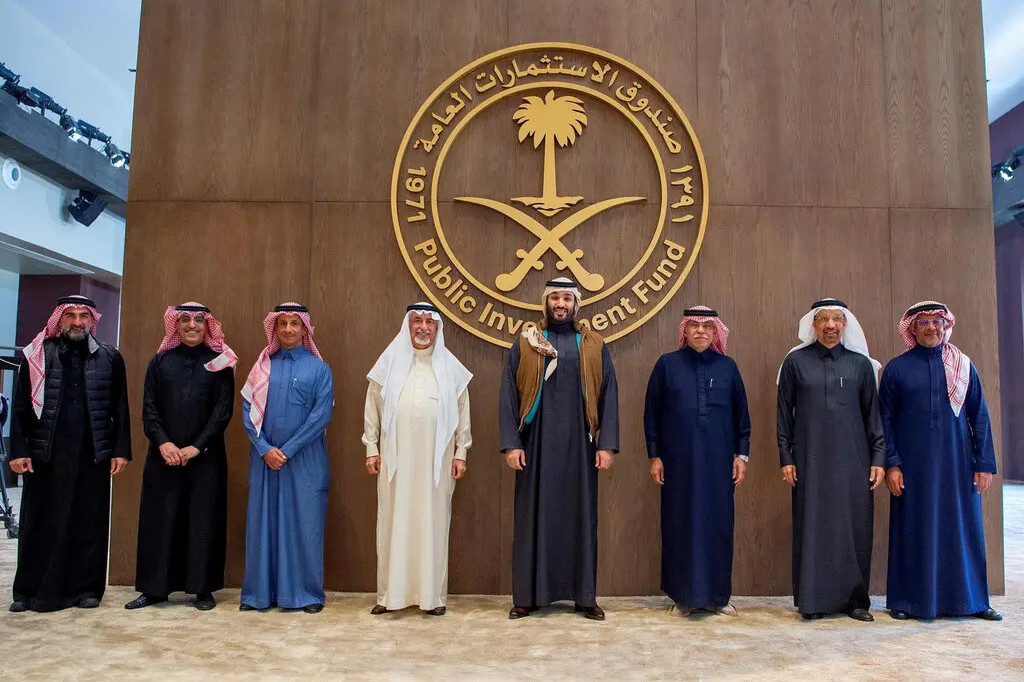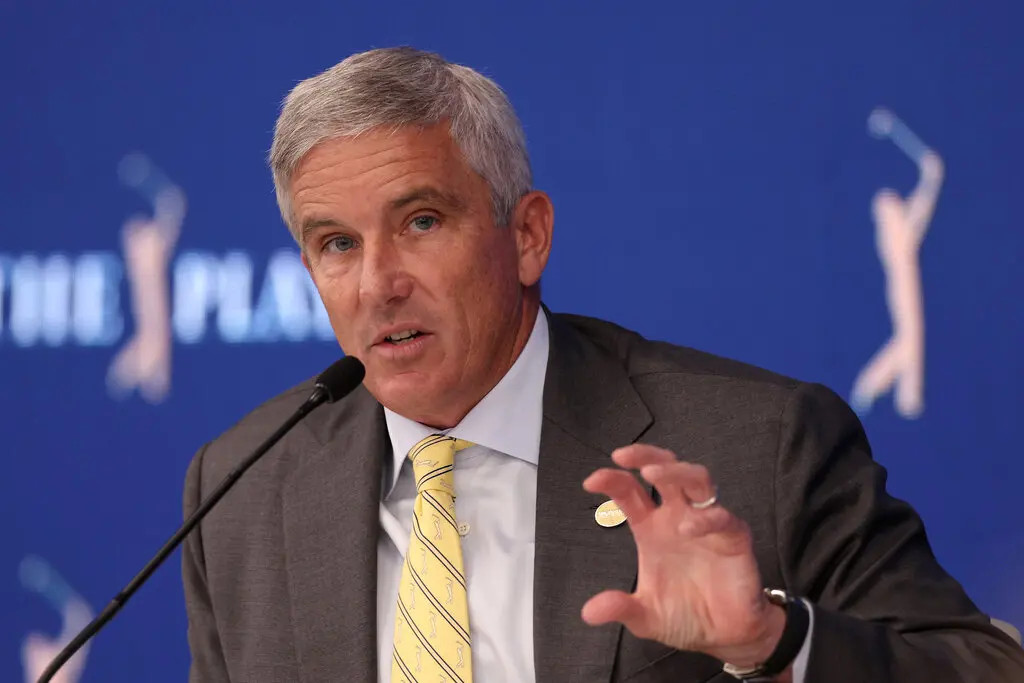
Date: 2024-10-19 Page is: DBtxt003.php txt00024782
SAUDI ARABIA
DEEP POCKETS BRINGS INFLUENCE
All About the Deep-Pocketed Saudi Wealth Fund That Rocked Golf ... The secretive $700 billion investment fund has set its sights on tourism, job creation, private equity and, now, golf.
DEEP POCKETS BRINGS INFLUENCE
All About the Deep-Pocketed Saudi Wealth Fund That Rocked Golf ... The secretive $700 billion investment fund has set its sights on tourism, job creation, private equity and, now, golf.

Several men in dark robes and head scarves stand in front of a wooden panel with a golden emblem on it that says “1971 Public Investment Fund” beneath Arabic script and two swords. ... Numerous Saudi officials, including the governor of the Saudi Public Investment Fund, Yasir al-Rumayyan, and Crown Prince Mohammed bin Salman, center, in Riyadh, Saudi Arabia, in 2021.Credit...Reuters
Original article: https://www.nytimes.com/2023/06/07/world/middleeast/saudi-arabia-sovereign-wealth-fund.html
Peter Burgess COMMENTARY
Peter Burgess
The secretive $700 billion investment fund has set its sights on tourism, job creation, private equity and, now, golf.
By Kate Kelly and Vivian Nereim ... Kate Kelly reported from New York, and Vivian Nereim from Riyadh, Saudi Arabia.
June 7, 2023
Behind the head-spinning news this week that the PGA Tour wants to merge with the upstart Saudi rival called LIV Golf is an entity with billions of dollars to back the deal: Saudi Arabia’s sovereign wealth fund.
Though the fund has long been an outsize presence in financial circles, the deal that stunned the golf world has turned a Klieg light on a Saudi business that has been described as one of the most opaque in the world. What is the Saudi sovereign fund?
Here’s what to know about the Saudi fund.
Known as the Public Investment Fund, or P.I.F., it is an investment pool that manages more than $700 billion in Saudi government money.
It invests those funds in companies, real estate and other ventures domestically and globally to generate profits, ostensibly for the benefit of the Saudi economy.
The fund, established in 1971 by royal decree, has its headquarters in Riyadh, Saudi Arabia, and offices in Hong Kong, London and New York. P.I.F. has grown rapidly in recent years, funding ambitious tourism and commercial undertakings it calls “giga projects.”
How does the Saudi fund rank globally?
It isn’t the largest in the world: That would be Norway’s, which currently manages $1.4 trillion, according to the Sovereign Wealth Fund Institute.
Who runs the Saudi fund?

A man in a dark shirt and baseball cap swings a golf club ... Yasir al-Rumayyan, who leads the Public Investment Fund, playing in the inaugural LIV Golf Invitational last year.Credit...Paul Childs/Action Images Via Reuters
The P.I.F. is led by a governor, Yasir al-Rumayyan, a onetime banker and chairman of Saudi Aramco, the country’s national oil company. He also hosts “Davos in the Desert,” the annual conference in Riyadh.
But the real power behind the purse strings, analysts say, is Crown Prince Mohammed bin Salman, Saudi Arabia’s de facto leader, who chairs the Public Investment Fund’s board.
Prince Mohammed has made the fund a cornerstone of his economic growth plan, Vision 2030, a blueprint to wean Saudi Arabia off its dependency on petrowealth and expand its economy into technology, health care and other areas.
The plan aims to create private-sector jobs for the kingdom’s large youth population, while allowing new liberties for women. The 37-year-old crown prince has also set a goal of growing the Public Investment Fund’s assets to $3 trillion by 2030.
What are some of the fund’s investments?
Under Prince Mohammed, the fund has invested in an array of international companies, including Uber, the private-equity firm Blackstone, the Japanese conglomerate SoftBank and sports franchises like the English Premier League soccer team Newcastle United.
It is backing a futuristic city in the Saudi desert named Neom, announced a new airline this year, Riyadh Air, with the purchase of 72 Boeing Dreamliners, and says it is committed to a “green” strategy.
On Tuesday, the Public Investment Fund said that LIV Golf was merging with the PGA Tour and DP World Tour, a European golf circuit, in hopes of creating a global behemoth in the sport.
What was the reaction?
The word “shock” is being tossed around a lot.
For one thing, some key people were left out of the negotiations, which were secret. Golf fans also certainly did not see it coming.
But many in Saudi circles were ecstatic, seeing it as a countervailing narrative against a stream of negative press. “I’m not going to lie: This is a moment that a lot of us are relishing,” Prince Talal Al Faisal, a Saudi businessman and royal family member, said in an interview.
When the LIV tour was launched in 2021, bankrolled by the sovereign wealth fund, it telegraphed a sharp break from golf’s traditional mores — and instantly split the world of men’s professional golf.
It was seen as a breakaway league and a threat to the PGA Tour. It lured golf stars like Phil Mickelson (with a reported $200 million) to become frontmen. The PGA Tour scrambled to catch up by raising its payouts.
Bigger stars like Tiger Woods had harsh words for the new league and for Greg Norman, who became the Western face of LIV as its commissioner. With LIV poaching some of the most widely known players from the established PGA Tour, the PGA banished them.
How did the deal happen?

A man in a dark suit and yellow tie speaks into a small microphone. ... The PGA Tour commissioner, Jay Monahan. Credit...Richard Heathcote/Getty Images
In hush-hush meetings presumably sweetened by promised riches.
Mr. al-Rumayyan, a close confidant of Prince Mohammed’s, spearheaded the talks over the past month and a half with the PGA Tour’s commissioner, Jay Monahan.
“I recognize that people are going to call me a hypocrite,” Mr. Monahan said after the announcement. “But circumstances do change.”
But what about the rancor and the controversies?
The new league, the sovereign fund, the Saudi government and the royal family have all been tarred at some point with a patina of scandal.
LIV’s birth prompted litigation with the PGA Tour, and the latter came under scrutiny from Justice Department antitrust investigators, who were examining whether the tour’s efforts to block LIV had undermined golf’s labor market.
The Saudi investment fund has raised eyebrows by entrusting billions of dollars to former Trump administration officials, including an investment firm run by Jared Kushner, former President Donald J. Trump’s son-in-law; and another run by former Treasury Secretary Steven Mnuchin.
It has invested in Russian infrastructure. And it was accused of having a role in purchasing the aircraft that ferried the killers of the dissident Saudi writer Jamal Khashoggi to Turkey, where he was slain and his body cut into pieces, according to Turkish security officials. A U.S. intelligence report said the Saudi crown prince had approved the assassination.
The Saudi government has locked up women who campaigned for the freedom to drive and detained senior royals in what critics viewed as a consolidation of power and a shakedown. Saudi Arabia has also played a proxy role in devastating conflicts in places like Yemen, where a Saudi-led coalition has been fighting the Iran-backed Houthi rebels since 2015.
What happens now?
Experts say if the deal sticks, it has the potential to reshape golf as we know it.
Most terms of the deal weren’t disclosed, and it may yet fall through amid scrutiny from international regulators and the PGA Tour’s board, which must approve it.
Under the agreement announced on Tuesday, litigation between the former rivals would vanish like a golf ball in tall grass. The fate of the antitrust inquiry is not as clear.
The plan is for Mr. al-Rumayyan to lead the board of the new for-profit entity. (He was previously a board member at Uber and SoftBank Group.)
In an interview on the Saudi Arabian podcast “Socrates” last year, Mr. al-Rumayyan pronounced his love for golf — “it’s a really enjoyable sport, one of the best sports” — and extolled the crown prince’s goals for the Public Investment Fund.
“We have a full plan from here to 2030, how we first reach the trillion, then how we reach from two to three” trillion, he said. “The crown prince is insisting on $3 trillion.”
Kristian Coates Ulrichsen, a Middle East fellow at Rice University’s Baker Institute for Public Policy, called the deal “highly strategic” by Prince Mohammed. He said it “reaches a segment of Middle America, also beyond the Beltway, and really engages with them to tell the story of a changing Saudi Arabia.”
The message, he said? “This isn’t the Saudi Arabia you thought you knew based on 9/11 or Khashoggi or Yemen.”
Kate Kelly covers money, influence, and policy as a correspondent in the Washington bureau of the Times. Before that, she spent twenty years covering Wall Street deals, key players and their intersection with politics. She is the author of three books, including 'The Education of Brett Kavanaugh.' @katekelly
Vivian Nereim is the Gulf bureau chief. She has more than a decade of experience in the Arabian Peninsula and was previously a reporter for Bloomberg News covering Saudi Arabia. @viviannereim
- Sign up for the On Golf newsletter. Our coverage of golf’s most interesting stories and athletes, delivered during the biggest tournaments in the sport. Get it sent to your inbox.
Editors’ Picks
- Her Symptoms Suggested Long Covid. But Was That Too Obvious?
- Colombia’s Mustard Lovers Grow Desperate Amid Saucy Shortage of Dijon
- This Is Ischia’s Moment in the Sun